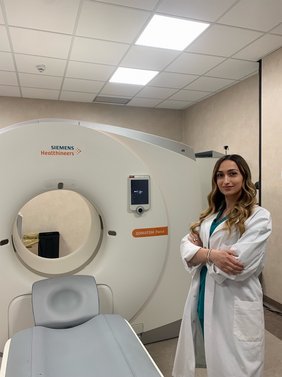Factors Associated With Complete Pathologic Necrosis of Hepatocellular Carcinoma on Explant Evaluation After Locoregional Therapy: A National Analysis Using the UNOS Database
Sarwar A, Bonder A, Hassan L, Malik MS, Novack V, Curry M, Ahmed M.
AJR Am J Roentgenol. 2023 May;220(5):727-735. doi: 10.2214/AJR.22.28385. Epub 2022 Dec 7. PMID: 36475810.
Hepatocellular carcinoma (HCC) is one of the most common indications for liver transplant (LT) [1]. Complete pathologic necrosis (CPN) obtained by different types of locoregional therapies (LRTs) before LT is associated to a lower 5-year estimated risk of recurrence and better 5-years recurrence-free and disease-specific survival rates [2].
So far, the most widespread LRT is transarterial chemoembolization (TACE) [3-6], followed by thermal ablation and transarterial radioembolization [TARE]. However, the choice of the most appropriate locoregional therapy varies widely among institutions. Notwithstanding the importance of CPN as a significant predictor of recurrence-free survival and overall survival, The American Association for the Study of Liver Diseases guidelines for treating HCC do not recommend a particular type of LRT over another as a bridge to LT [7] due to the paucity of studies reporting an improved survival.
The current study [8] aims to examine the type of LRT associated with higher rates of CPN on explant evaluation, as well as patients characteristics, HCC and transplant-center features associated.
The final study population consisted of 6265 patients (median age, 62 years [IQR, 58–66 years]; 1505 [23.1%] women, 4760 [76.9%] men) who underwent LT after a single type of LRT for HCC measuring 3 cm or smaller.
From The United Network for Organ Sharing (UNOS) database authors obtained information about the necrosis percentage at the explant evaluation, patient’s clinical and laboratory features, HCC’s characteristics like size and several transplant center’s data (e.g. median waiting time for LT).
Out of the 6265 patients included, 4352 (69.5%) performed TACE, 1217 (19.4%) underwent thermal ablation and 696 (11.1%) were treated by TARE. On explant evaluation, CPN for all HCCs was achieved in 23.5% (1475/6265) of patients.
The CPN rate was 18.5% (805/4352) in patients who underwent TACE, 35.8% (436/1217) in patients who underwent thermal ablation, and 33.6% (234/696) in patients who underwent TARE.
Centers (n = 118) were stratified into tertiles according to the CPN rate; the first tertile comprised 40 centers with a CPN rate of 0.0–17.5%; the second tertile comprised 39 centers with a CPN rate of 17.6–27.6%, and the third tertile comprised 39 centers with a CPN rate of 27.7–50.0%. Centers in the second and third tertiles performed higher number of thermal ablation (23.6% and 25.5%, respectively) than centers in the first tertile (14.4%) (p = .02). A higher number of TAREs were performed in the third tertile (14.7%) than centers in the second tertile (12.3%) and first tertile (5.2%) (p = .03). These data showed a higher CPN rate percentage in centers where TAREs and thermal ablations were performed more frequently than TACEs.
Considering laboratory findings of patients with CPN and without CPN, authors reported α-fetoprotein level (AFP) at the time of LRT lower in CPN group (6.0 ng/mL vs 7.0 ng/mL, p < .001), as well as model for end-stage liver disease (MELD) score at the time of LRT (10.0 vs 11.0, p < .001). Patients with CPN, were also more likely to have a single HCC (79.7% vs 67.6%, p< .001) and a smaller median size of the largest HCC (1.0 cm vs 1.3 cm, p< .001).Despite several limitations of the study, mainly related to the lack of patients’ information (the reason why a particular type of LRT was selected, the position of HCC within the liver, radiologists experience, technical aspects of LRTs, post procedural complications, survival rate after LT), TARE seems to be superior to TACE and equivalent to thermal ablation in terms of CPN rates.
In conclusion, the overall rate of CPN was low among patients who underwent LT after LRT for HCC measuring 3 cm or less in the United States. The use of thermal ablation or TARE, rather than TACE, showed a significant independent association with an increased likelihood of CPN.
References:
- Wang S, Toy M, Hang Pham TT, So S. Causes and trends in liver disease and hepatocellular carcinoma among men and women who received liver transplants in the U.S., 2010-2019. PLoS One. 2020 Sep 18;15(9):e0239393.
- Agopian VG, Morshedi MM, McWilliams J, et al. Complete pathologic response to pretransplant locoregional therapy for hepatocellular carcinoma defines cancer cure after liver transplantation: analysis of 501 consecutively treated patients. Ann Surg. 2015 Sep;262(3):536-45; discussion 543-5.
- DiNorcia J, Florman SS, Haydel B, et al. Pathologic Response to Pretransplant Locoregional Therapy is Predictive of Patient Outcome After Liver Transplantation for Hepatocellular Carcinoma: Analysis From the US Multicenter HCC Transplant Consortium. Ann Surg. 2020 Apr;271(4):616-624.
- Welling TH, Eddinger K, Carrier K, et al. Multicenter Study of Staging and Therapeutic Predictors of Hepatocellular Carcinoma Recurrence Following Transplantation. Liver Transpl. 2018 Sep;24(9):1233-1242.
- Manzia TM, Lai Q, Iesari S, et al. Impact of remnant vital tissue after locoregional treatment and liver transplant in hepatocellular cancer patients, a multicentre cohort study. Transpl Int. 2018 Mar 23.
- Pommergaard HC, Rostved AA, Adam R, et al; European Liver and Intestine Transplant Association (ELITA). Locoregional treatments before liver transplantation for hepatocellular carcinoma: a study from the European Liver Transplant Registry. Transpl Int. 2018 May;31(5):531-539.
- Heimbach JK, Kulik LM, Finn RS, et al. AASLD guidelines for the treatment of hepatocellular carcinoma. Hepatology 2018; 67:358–380.
- Sarwar A, Bonder A, Hassan L, et al. Factors Associated With Complete Pathologic Necrosis of Hepatocellular Carcinoma on Explant Evaluation After Locoregional Therapy: A National Analysis Using the UNOS Database. AJR Am J Roentgenol. 2023 May;220(5):727-735.
- Young S, Golzarian J. Locoregional therapies in the treatment of 3- to 5-cm hepatocellular carcinoma: critical review of the literature. AJR 2020; 215:223–234.
Dr. Paola Capodiferro is a second-year radiology resident at “Sapienza, University of Rome”. She completed her undergraduate medical degree at “Sapienza, University of Rome” and she is undertaking training in diagnostic and interventional radiology. Her main fields of interests in the area of diagnostic imaging are abdominal, gastrointestinal and urogenital radiology.
Comments may be sent to paola.capodiferro@uniroma1.it


